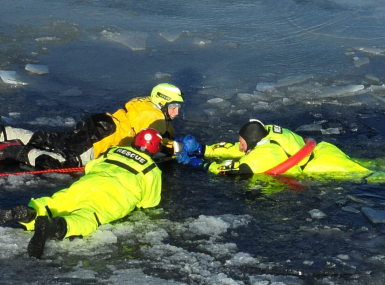Across mountains, two Oregon counties pledge disaster aid
 Photo courtesy of Tillamook County
Photo courtesy of Tillamook County
Tillamook County, Ore. public works crews clean up after a flood.
If a tsunami hits the Oregon coast, Tillamook County Public Works Director Liane Welch doesn't expect the cavalry to come from the state capital in Salem. She expects it to ride over the Cascade Mountains in a helicopter. It's not that she lacks confidence in the state government, but if her coastal county is in the midst of a major disaster, particularly a tsunami resulting from a Cascadia subduction zone earthquake, her first assistance will likely come from Tillamook's sister county, Umatilla. It's a mutual aid partnership she's developed that she'd like to see other sets of counties in her state emulate. The Cascadia subduction zone is the convergence between two tectonic plates in the Pacific Ocean stretching from British Columbia in Canada to Northern California. The Oregon Seismic Safety Policy Advisory Commission says a massive earthquake near the subduction zone is overdue, the last one having taken place in 1700. The commission's 2014 report anticipates the earthquake and subsequent tsunami will disrupt water, power, heat, gas and telephone service. The state has planned an emergency exercise in 2016 to prepare. But aid from the state's disaster plan, Welch said, may not address the personal needs of her 22 staff members in the public works department. "If we get hit with something my people are going to have a lot to worry about, not just their work," she said. "We're going to be victims of the disasters, too and have emergencies with our own families, and our minds won't be completely on our jobs. "You can only work 24 hours a day for a day-and-a-half before your performance starts to suffer, but if you're also trying to manage your own family or home, it will happen a lot faster. There will be a leadership void, and we'll need help to fix that." So a crew from Umatilla County's public works department will arrive by helicopter to complement the Tillamook crew for up to two weeks. The mountains between the counties are key, she said, because they divide the state into two different environments, with different needs and vulnerabilities. While the coast will take the brunt of the earthquake and tsunami, the eastern counties will be relatively safe and able to spare personnel. Likewise, disasters characteristic of the east but not the west offers Tillamook County a chance to help Umatilla. "I was in Eastern Oregon when Mount St. Helens erupted in 1980," said Tom Fellows, Umatilla County's public works director. The volcano deposited six inches of ash on Umatilla County. "We have a whole bunch of volcanoes to our west. Who is going to help us if they blow?" Wildfires and flooding from the Columbia River could also pose a threat to Umatilla County. Despite that, Fellows said he wasn't thinking about his county when he signed on to be Tillamook County's sister county. "We saw it as a chance to help another county," he said. "I look at what happened in New Orleans and I saw the folks who recover the quickest are the ones with the plan to get started."
Attachments
Related News

County officials moonlight in search and rescue roles
For some county officials, participating in search and rescue operations is another way to serve their communities, and make it safer for people to enjoy natural recreation resources.

SUPPORT Reauthorization Act of 2025: What it means for counties
On December 1, the bipartisan SUPPORT for Patients and Communities (SUPPORT) Reauthorization Act of 2025 (H.R. 2483) was signed into law. The reauthorization renews vital federal funding for programs that seek to prevent opioid overdoses and expand treatment and recovery options.

DHS releases FY 2026 funding opportunities for World Cup and Counter-UAS grants
The U.S. Department of Homeland Security (DHS) and the Federal Emergency Management Agency (FEMA) have released the FY 2026 Notices of Funding Opportunity (NOFOs) for two major new homeland security grant programs: the FIFA World Cup Grant Program and the Counter-Unmanned Aircraft Systems (C-UAS) Grant Program.

